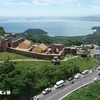 Cu Chi Tunnels, a popular destination for both domestic and foreign tourists thanks to its unique historical and architectural values, may soon join UNESCO’s list of world heritage. The People’s Committee of Ho Chi Minh City is working on a dossier seeking UNESCO’s recognition for the tunnels. In the photo: Conference chamber at Cu Chi Tunnels can accommodate more than 20 people. (Photo: VNP/VNA)
Cu Chi Tunnels, a popular destination for both domestic and foreign tourists thanks to its unique historical and architectural values, may soon join UNESCO’s list of world heritage. The People’s Committee of Ho Chi Minh City is working on a dossier seeking UNESCO’s recognition for the tunnels. In the photo: Conference chamber at Cu Chi Tunnels can accommodate more than 20 people. (Photo: VNP/VNA)  Initially, the tunnels had only short paths and simple structure that were used to hide documents, weapons and resistance members deep inside the enemy-controlled area. Only during the anti-American war were the tunnels reinforced and widened. (Photo: VNP/VNA)
Initially, the tunnels had only short paths and simple structure that were used to hide documents, weapons and resistance members deep inside the enemy-controlled area. Only during the anti-American war were the tunnels reinforced and widened. (Photo: VNP/VNA)  Beginning in 1961, when the Party Committee and headquarters of the Sai Gon-Gia Dinh Military Region of the liberation forces chose Cu Chi as an operating area, the tunnel system maximized its use for years, especially in 1966, against the Americans broadening the war in the South. In the photo: Cu Chi Tunnels model (Photo: VNP/VNA)
Beginning in 1961, when the Party Committee and headquarters of the Sai Gon-Gia Dinh Military Region of the liberation forces chose Cu Chi as an operating area, the tunnel system maximized its use for years, especially in 1966, against the Americans broadening the war in the South. In the photo: Cu Chi Tunnels model (Photo: VNP/VNA)  With their indomitable strength, Cu Chi’s resistance forces and local people created a system of crisscrossing tunnels with multiple floors, with more than 200km of underground trenches in total. In the photo: The famous non-smoking ‘Hoang Cam’ kitchen in the tunnel. (Photo: VNP/VNA)
With their indomitable strength, Cu Chi’s resistance forces and local people created a system of crisscrossing tunnels with multiple floors, with more than 200km of underground trenches in total. In the photo: The famous non-smoking ‘Hoang Cam’ kitchen in the tunnel. (Photo: VNP/VNA)  Built by South Vietnamese liberation forces as shelter from US and Sai Gon troops during the war, the site is known over the world. (Photo courtesy of Cu Chi Tunnels)
Built by South Vietnamese liberation forces as shelter from US and Sai Gon troops during the war, the site is known over the world. (Photo courtesy of Cu Chi Tunnels)  Located in Tan Phu Trung and Phuoc Vinh An communes in Cu Chi district, about 70km from downtown HCM City, the tunnels were built by local residents and soldiers using simple tools from 1946 to 1968 as shelters from US and Saigon troops during the war. (Photo: VNP/VNA)
Located in Tan Phu Trung and Phuoc Vinh An communes in Cu Chi district, about 70km from downtown HCM City, the tunnels were built by local residents and soldiers using simple tools from 1946 to 1968 as shelters from US and Saigon troops during the war. (Photo: VNP/VNA)  Ben Duoc Memorial is constructed to tribute soldiers who sacrificed their life during the war. (Photo courtesy of Cu Chi Tunnels)
Ben Duoc Memorial is constructed to tribute soldiers who sacrificed their life during the war. (Photo courtesy of Cu Chi Tunnels) VNA

































